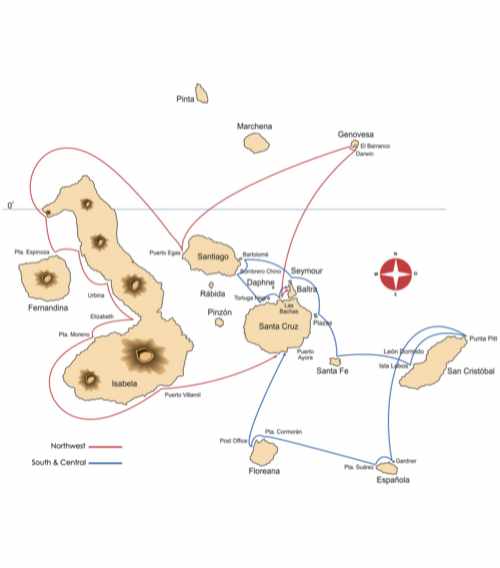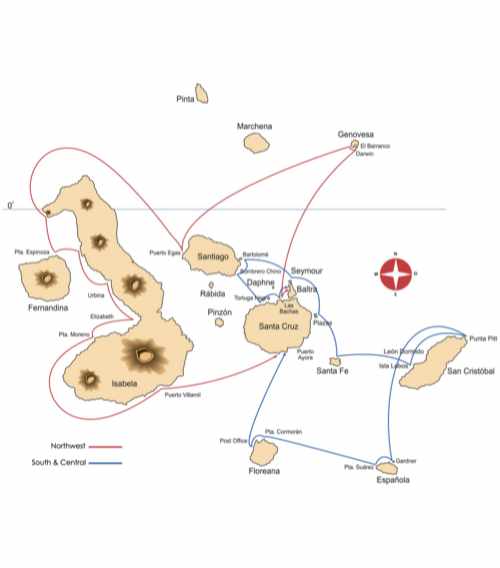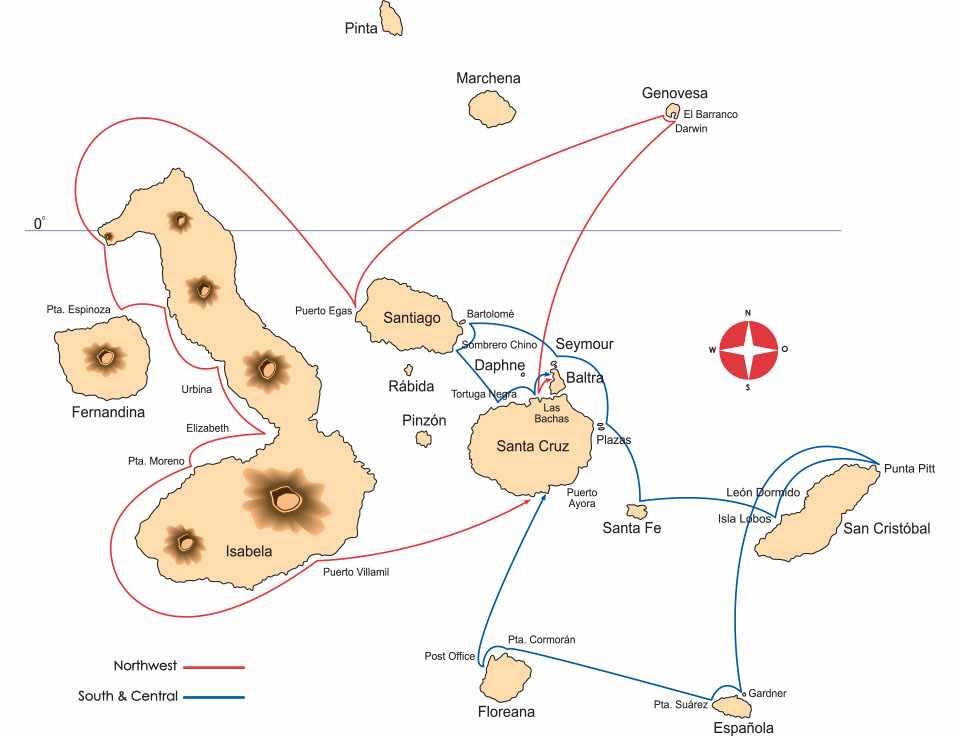Beagle
The newly remodeled Beagle is named for the HMS Beagle, on which Charles Darwin visited the Galapagos Islands during the historic voyage that led to his ground breaking theory of evolution, inspired to a great extent by his observations in this extraordinary archipelago.
A magnificent 105-foot twin screw steel-hulled brigantine with teak decks and beautifully designed interiors, The Beagle is a classic among sailing yachts in the Galapagos and one of the friendliest and most comfortable. She was built by Cubow Ltd. in Woolwich, England. She’s been a charter vessel in the Islands for over a decade and has been substantially refurbished and continually upgraded under her current ownership.
The Beagle has just seven cabins, making her an excellent choice for anyone that wants to experience the wonder of the Galapagos on a small vessel. Accommodating just 14 guests per trip, it’s easy to feel a sense of comradeship while benefitting from personalized service. The cabins have air conditioning and a private bathroom for your total comfort. Tasty meals and snacks are served in the outdoor dining area, and you can also enjoy the views and breeze from the sun deck and observation deck. You can also opt to sit indoors in the air-conditioned lounge, complete with an A/V system and library. The onboard naturalist is a great source of knowledge about the diverse wildlife and the area’s history and terrains. Snorkeling gear can be borrowed and the Beagle also has kayaks.
The Beagle is a very fun way to do the Galapagos. She runs a 7-night South East Itinerary Tuesday to Tuesday followed by a 7-night North West Itinerary. You can do the ultimate Galapagos 14-night itinerary!
Boat Specifications
Length - 32m/105ft
Beam -6m/22ft
Cruising speed - 9 Knots
Engines - Twin John Deere 235 HP (2004)
Max guests - 14
Number of cabins - 6
Number of bathrooms - 6
Tenders - 1 x Boston Whaler dinghy
Freshwater maker - 35 gallons per hour
Boat Navigation and Safety
Radar
Depth Sounder
GPS
Radio VHF/DSC/SSB
E.P.I.R.B. Distress System
Emergency Rafts
Life Vests
Fire Alarm & Fire Extinguishers
Oxygen
First Aid Kits
Satellite & mobile phones
Bilge pump alarm
Crew trained in first aid
Emergency flares
Boat features
Daily housekeeping
Library
Air Conditioned saloon
Aircon Cabins
Sun Deck
Indoor Saloon
Warm Water Showers
Outdoor Dining
Non-Smoking Rooms
Kayaks On-Board
Snorkeling Equipment
Dedicated Local & International Crew
Nearly 1:1 Crew-to-Guest Ratio
Naturalist Guide
Leisure Deck
Bar
Budget Friendly Cruise
Family Friendly Cruise
South East Galapagos Itinerary
Tuesday to Tuesday
Day 1 - Tuesday, Baltra Airport - Puerto Ayora
Arriving guests from Baltra Airport will be met by a transfer guide and taken on board The Beagle to settle into your cabins and have a snack before going to the Darwin Station in the afternoon. Afterwards you may stroll through Puerto Ayora's main street with time to explore the shops.
The Charles Darwin Research Station is on Santa Cruz Island which is the main inhabited island in the archipelago, with a population of approximately 16,000. A visit to the station will increase one's understanding of the work being done by the foundation and the importance of preserving the archipelago's ecosystems. A series of walkways takes you through the captive breeding program where you will see juvenile and adult tortoises from different islands and famous Lonesome George, the very last of his species.
Day 2 - Wednesday, Floreana
This morning, the Beagle heads to Floreana. Puerto Velasco Ibarra has the smallest human settlement in the Islands. Floreana was inhabited as early as the 1920's and has a colorful history of pirates, whalers, convicts and colonists. You will be driven up into the highlands on a dirt road in an open-sided bus known locally as a chiva. You'll pass through chacras (small land holdings) up to a small fresh-water spring called Asilo de la Paz and visit a tortoise corral. On returning to The Beagle you'll motor to Punta Cormorant and from there take the dinghy to go for a snorkel at Devil’s Crown, a sunken cone with exciting snorkeling as you’re carried by the current while seeing a superb variety of marine life.
Afternoon voyage to Punta Cormorant where you land on a beach with green olivine sand. Several trails allow you to explore a brackish water lagoon with a colony of flamingos who are there most of the year, and white-cheeked pintail ducks, stilts, and other shorebirds feeding alongside the flamingos. The trail then goes over a hill and dunes to a stunning white beach consisting of ground coral, where the green sea turtles nest.
Day 3 - Thursday, Hood
Morning trip to Punta Suarez. Hood Island is one of the most popular and attractive islands. The quantity and variety of wildlife here are remarkable. At Punta Suarez you can see the waved albatross from April to December. Blue-footed bobbies, Nazca boobies, Galapagos hawks, Darwin finches, swallow-tailed gulls, Espanola mockingbirds, shorebirds, sea lions, marine iguanas and lava lizards are just some of its residents, and an impressive blowhole can be observed from the high cliffs.
Afternoon visit to Gardner Bay. Located on the eastern end of the island Gardner Bay has a wonderful sandy beach for swimming and observing the Galapagos sea lions.
Day 4 - Friday, San Cristobal
Morning arrival to Punta Pitt on San Cristobal Island and affording impressive views after climbing up a steep narrow path onto a plateau surrounded by reddish hills. Depending on the time of year there may be nesting marine iguanas, redfooted boobies and other marine birds down on the cliffs. After the visit The Beagle will navigate to Kicker Rock where rocks rise 500 feet out of the ocean and resemble a sleeping lion, hence its name in Spanish, 'León Dormido'. While you go around it you'll be able to observe the narrow channel that separates these two rocks. Several marine bird species nest there.
The afternoon anchorage is at Isla Lobos and, as its name suggests, it has a sea lion colony and also an endemic lava lizard . It's a good site for swimming and snorkeling alongside the sea lion pups, and on the islet you can visit the sea lion colony. Perhaps you'll see the frigate birds displaying and building their nests, if their food supply is good.
Day 5 - Saturday, Santa Fe
One of the most beautiful coves of all visitor sites in the Galapagos, Santa Fe has a turquoise cove sheltered by a peninsula extending from the shore by a row of rock covered in Opuntia cactus and sea lions. This island was formed by an uplift caused by tectonic activity. You can see land iguanas, sea turtles, Galapagos hawks, sea lions, and a forest of giant Opuntia cactus, and it's lovely to swim and snorkel in the clear turquoise blue sea.
South Plaza is one of the best spots in the archipelago to see land iguanas and swallow-tailed gulls, both indigenous to the Galapagos. There are iguana nests scattered all over the hill. The sheer cliffs of the southern shore are a perfect bird habitat, making it an unparalleled bird observatory for especially swallow-tailed gulls, Audubon shearwaters, and red-billed tropicbirds.
Day 6 - Sunday, North Seymour
North Seymour is home to several species of marine birds: swallow-tailed gulls, blue-footed boobies, noddy terns and both the great and the magnificent frigate birds compete for nesting sites. Land iguanas are found alongside marine iguanas, and there are the ever-present comic sea lions as well. North Seymour is a low, flat island located north of Baltra that was uplifted from the sea by underground seismic activity.
Afternoon trip to Sullivan Bay. Bartolome Island is a small island located to the east of James Island. Famous for its Pinnacle Rock, it is home to a small rookery of Galapagos penguins. You can swim and snorkel around Pinnacle Rock, or walk to the other side of the island to see sea turtles nesting (from January to March) and sharks swimming close to shore. You can also climb to the highest point of the island, a climb which gives you the chance to see plants that live in lava and ash and many interesting lava formations. On this island we also see sea lions, Galapagos penguins, pelicans, Galapagos hawks, turtles and sharks.
Day 7 - Monday, Chinese Hat & Santa Cruz
Chinese Hat is a little island shaped as its name implies which sits off the southeastern tip of James Island. Its small white beaches have a sea lion colony. Snorkeling is usually very good, and with luck you might see the Galapagos penguins in the water.
Cerro Dragon Located on the northwest coast of Santa Cruz Island, the visit to Cerro Dragon (“dragon hill”) will take you through Palo Santo trees and Opuntia cactus past a couple of lagoons where flamingoes can be seen and the shy land iguana live.
Day 8 - Tuesday, Black Turtle Cove, Departure
Your visit to Black Turtle Cove is with the dinghy to permit you to motor through the mangrove inlets. These lagoons provide a refuge to rays, sharks, and sea turtles that are clearly visible alongside the boat. The engine is turned off and you slowly approach the different species that live in this peaceful place. Your guide will take you to the airport in a bus, a ten-minute ride.
Continuing passengers are not allowed to remain on board The Beagle during refueling; they can either go to the airport where there is a coffee bar and shops, or visit the small beach in the harbor. Departing visitors going to Baltra Airport and those who are remaining on The Beagle for a second week will all go together in a bus to the Gemelos, located in the highlands of Santa Cruz Island. These pit craters are just off the main road that crosses the island to the airport.

North - West Galapagos Itinerary
Tuesday to Tuesday
Day 1 - Tuesday, Baltra Airport
On arrival at Baltra Airport all visitors pay their entrance fee to the Galapagos National Park. You will then be met by the Beagle’s naturalist guide who will assist you with your luggage collection and accompany you on a short bus ride to the harbor to board The Beagle.
After a light lunch The Beagle will navigate to Las Bachas. Located on the northern shore of Santa Cruz Island. Las Bachas is a white sand beach that is a major nesting site for the green sea turtles. The name Las Bachas (“potholes”) refers to the indentations left in the sand by laying turtles or departing hatchlings. On the shore there are marine iguanas, and in the lagoon area flamingos are common. Visitors are welcome to swim from the beach.
Day 2 - Wednesday, Tower
After a dry landing you climb up the fairly steep Prince Philip’s Steps that take you onto a lava rock trail leading you through Palo Santo forest full of nesting birds. There’s a good chance of seeing the unique short-eared owl at this site.
After lunch and a snorkel along the amazing cliff sides, you visit the beach area of Darwin Bay, home to frigate birds, red-footed boobies, Nazca boobies, flycatchers, lava gulls, storm petrels and Darwin finches, to mention some of the birds found in this bay, formed from a caldera collapse.
Day 3 - Thursday, James Island
After a wet landing at James Bay onto a black beach, an easy stroll takes you near the coast line to observe tidal pools, marine birds, iguanas and sea lions, and often migratory birds are present in this area. This is also a good place to observe the Galapagos hawk. The trail ends at the fur sea lion grottos and, being nocturnal feeders, the fur seals sleep in and around the grottos during the day. On returning to the beach visitors may snorkel or swim. After lunch, The Beagle will start navigating to the west side of Isabela Island.
Day 4 - Friday, Isabela - Fernandina
Punta Vicente Roca offers a dinghy ride, excellent for marine life observation, to a snorkel area where underwater wildlife take full advantage of the nutrient-rich Cromwell current that upswells in this area. Fernandina is the youngest island of the archipelago. As you disembark at Punta Espinoza, you must be careful not to step on the marine iguanas piled up together to retain body heat. This visiting site is rich in wildlife, sea lions, flightless cormorants, penguins, herons, Sally light-foot crabs and much more, all living side by side on this small point with its mangrove forest.
Day 5 - Saturday, Isabela
The 30 minute hike at Tagus Cove takes you to the top of a cliff to view the volcanic landscapes of Darwin Volcano and Darwin Lake, the latter an uplifted ultra-saline lake saltier than the sea. Historically used as an anchorage site by pirates and whalers, this site is again an excellent place for marine and land birds.
Located to the south at the foot of the western side of Alcedo Volcano, Urbina Bay was uplifted in 1954 from the seabed leaving coral heads sitting out of the water. There is a large colony of land iguana, which has grown since the feral dogs and goats have been controlled through Project Isabela. It also affords an opportunity to see the Alcedo Volcano tortoise in its natural habitat.
Day 6 - Sunday, Isabela
Elizabeth Bay is a marine visitor site so the excursion is made by dinghy to the Mariela Rocks, where there is an important colony of Galapagos penguins. The dinghy ride takes you into a cove surrounded by red mangrove. Here in these quiet lagoons there may be green sea turtles, spotted eagle rays, golden rays, brown pelicans, small shark and flightless cormorants.
A lava walk takes you to a series of lagoons with plenty to see along the way. Darwin’s finches, Galapagos doves, penguins, blue-footed boobies, mockingbirds and flightless cormorants are some of the abundant wild life. Still on Isabela, the largest island in Galapagos, you will explore Punta Moreno, a desolate and pristine landscape of impressive black lava flows affording good views of Alcedo and Sierra Azul volcanoes.
Day 7 - Monday, Isabela
After breakfast, passengers head for the Sierra Negra volcano, the second largest volcanic crater in the world. It sits in the southern part of Isabela Island. Transportation is available to the end of the road, followed by a 45-minute walk on a trail to the top of the volcano from where the caldera can be viewed. Upon returning from the hike, passengers visit the Arnaldo Tupiza Breeding Center, to see the giant tortoises.
Lunch is served on the Beagle, and afterwards, those who wish to can go swimming in one of the Coves of Villamil Port. In the afternoon the boat begins traveling toward Puerto Ayora.
Day 8 - Tuesday, Puerto Ayora - Departure
Departing visitors going to Baltra Airport and those who are remaining on The Beagle for a second week will all go together in a bus to the Gemelos, located in the highlands of Santa Cruz Island. These pit craters are just off the main road that crosses the island to the airport. Departing passengers will be able to view the craters, and passengers remaining on board will have a full tour and visit the local farm Primicias where there are giant tortoises in their natural habitat.
Guests remaining for the second week will have lunch on The Beagle. Arriving guests from Baltra Airport will be met by a transfer guide and taken onboard The Beagle to settle into your cabins and have a snack before going to the Darwin Station in the afternoon. Afterwards you may stroll through Puerto Ayora’s main street with time to explore the shops.

